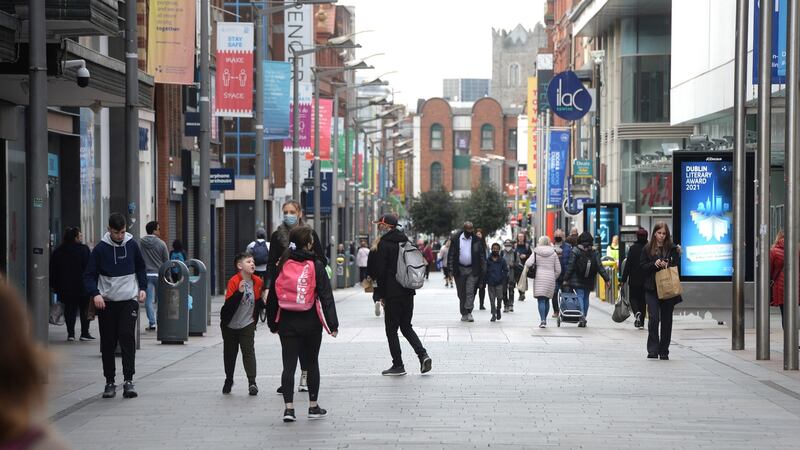The economy has taken a severe hit from the lengthy lockdown still underway. But the Irish economy has some advantages and hidden strengths which can help it rebound, once restrictions start to ease. Here are the five key factors which can boost recovery.
1. The vaccines are coming
As the vaccine programme proceeds, some tipping points should be reached where first deaths and then hospitalisation and cases fall. The Government is underplaying the potential vaccination numbers – it appears. In turn as the tipping points are reached, reopening can happen.

Moving into June, experience in Israel suggest that a wider reopening may be possible while still keeping virus numbers falling. Each country will be a bit different of course. And much depends on how virus numbers move between now and then.
However forecasters expect a significant bounce in the economy in the second half of the year. The latest Central Bank report refers to the prospect of a significant rebound and GDP growth of close to 6 per cent for all of the year, with domestic demand up nearly 3 per cent,compared to a fall of 5.4 per cent last year.
This year should be a game of two halves in economic terms. The economy will not be fully open and some restrictions will remain, but it will be a lot more normal from June on than things are now – and this means tax revenues for the exchequer and some significant revival in employment.
Ibec’s latest economic review said that the second half of the year “ will not see a return to normal trading in all sectors but there is potential for life and commerce to take a more normal rhythm.”
2. Savings in bank accounts
We have heard a lot about the excess savings in bank accounts from the part of the population who have remained in jobs. but have fewer opportunities to spend.
New Central Bank research this week by economists Reamonn Lydon and Tara McIndoe-Calder estimated that the excess savings built up during the pandemic are likely to amount to as much of €10 billion.
Most of it, they believe, was what might be terms forced savings due to an inability to spend, rather than precautionary savings, which is money put aside to deal with future threats.
Better-off households were more likely to have saved more, they found – and these households are a bit less likely to spend in future. However the economists estimated that about half, or €5 billion, of the savings could be spent after restrictions are lifted.
This is equivalent to about 5 per cent of total annual consumer spending – though it is unclear how quickly it might be spent. Some will be saved, used to pay down debt or go to longer term projects like a house deposit, home improvements or children’s education.
And it will be important to see how the money is spent – money spent on a staycation, for example, has a much bigger impact than cash spent on an overseas holiday.But this is a significant potential boost as the economy reopens.
3. The hidden sectors
There has understandably been a huge focus on the more visible closed sectors of the economy which have been hit really hard. But the multinational-dominated pharma and tech sectors and agrifood have continued and exports have continued to grow strongly.
Ibec's recent report pointed out that exports grew by 6.2 per cent, meaning Ireland was one of only two EU countries to increase its exports last year. The report saw three reasons for optimism on exports this year – renewed demand as restrictions ease worldwide, continued strength in key Irish sectors such as biopharma, medtech, ICT and food and the suspension of US tariffs on key dairy and drink products.
Meanwhile, public servants have continued to work along with many others in non consumer-facing domestic service sectors and in mainstream manufacturing.
4. Some job pluses
The news on jobs is generally negative. Both Ibec and the Central Bank expect the total numbers of work at the end of this year to be about 100,000 lower than they were before the pandemic, a really significant hit.
Many people will move off the Pandemic Unemployment Payment as sectors reopen and it will fall significantly from current levels. Also, some sectors continue to create additional jobs – Ibec points to to significant rises in employment last year in ICT, finance and industry.
Incomes – and total earnings – in some of the sectors who have remained open also continue to rise, in contrast to the devastation in areas like accommodation in food. Younger, lower-paid workers have been worst hit and females have been hit worse than males.
5. ECB policy
European Central Bank support has meant interest rates have remained on the floor. Despite sharp increases in US long-term borrowing rates in recent weeks, euro zone rates have remained low. Irish ten year interest rates have edged slightly higher, but yesterday remained below 0.1 per cent.
In turn, this allows the State to continue to borrow to support businesses and households. Without that, incomes would have collapsed last year – perhaps by 15 - 20 per cent.
Slowly withdrawing supports as sectors reopen will be tricky, however, and will mean that many companies go out of business. But rock bottom interest rates have meant that the State’s response to this economic shock has been to spent more, in direct contrast to the austerity which followed the financial collapse in 2008.












